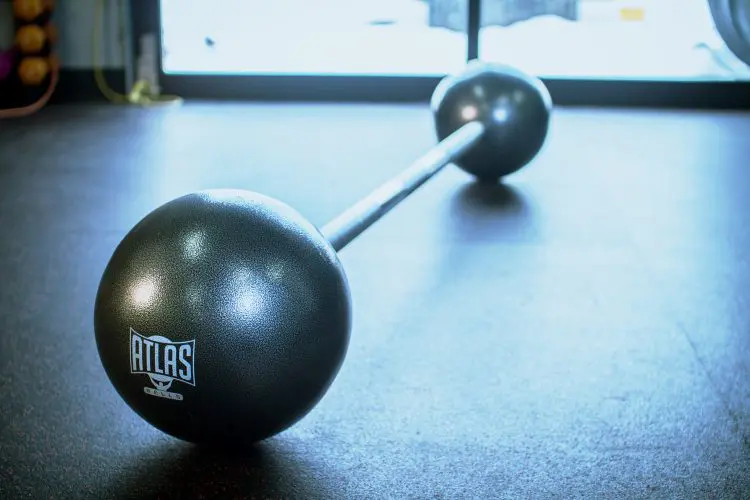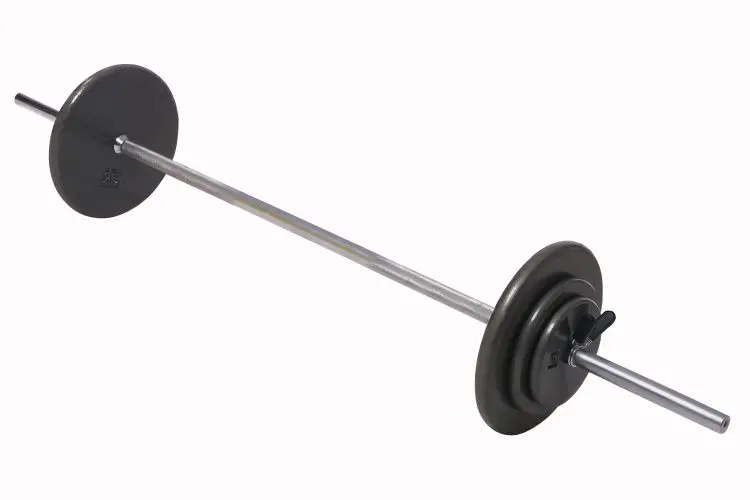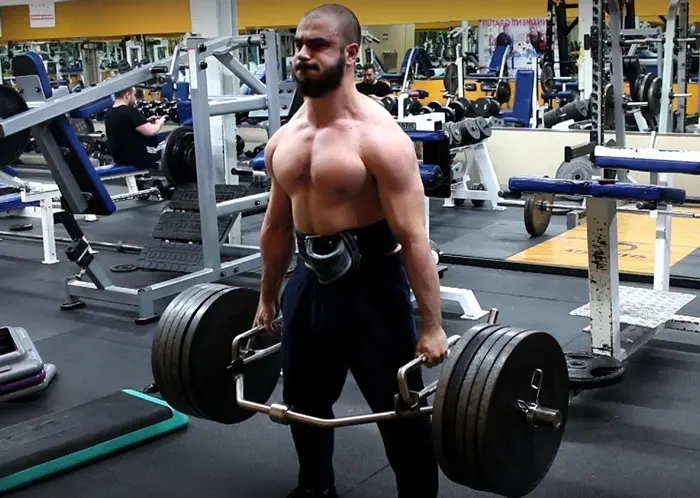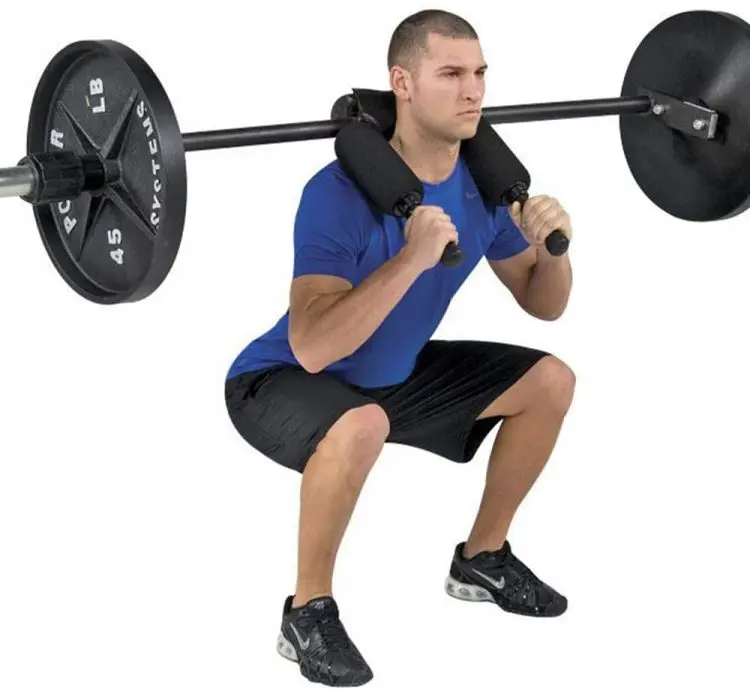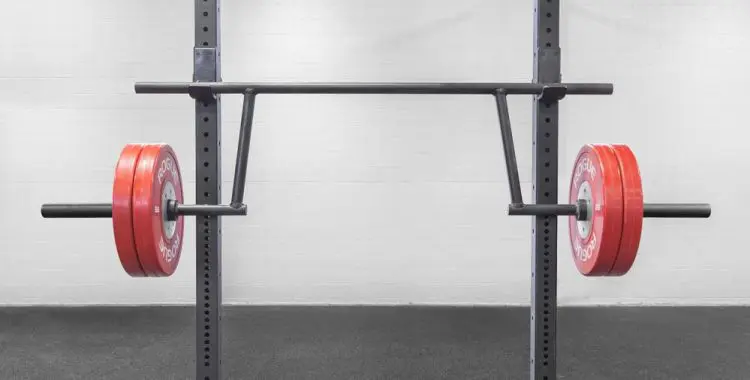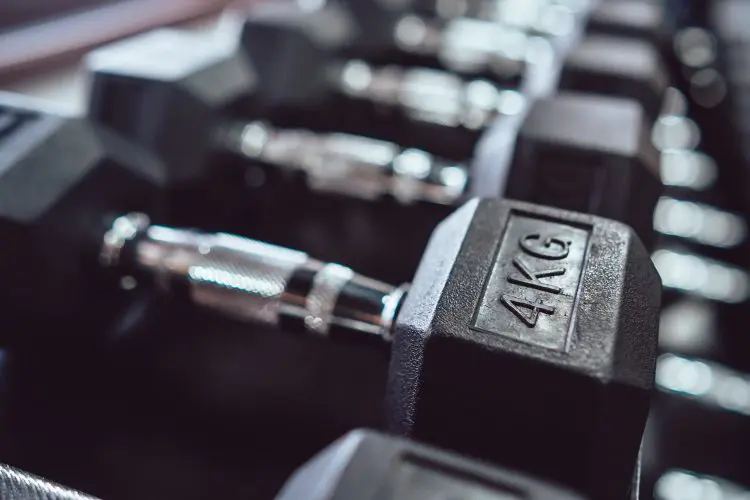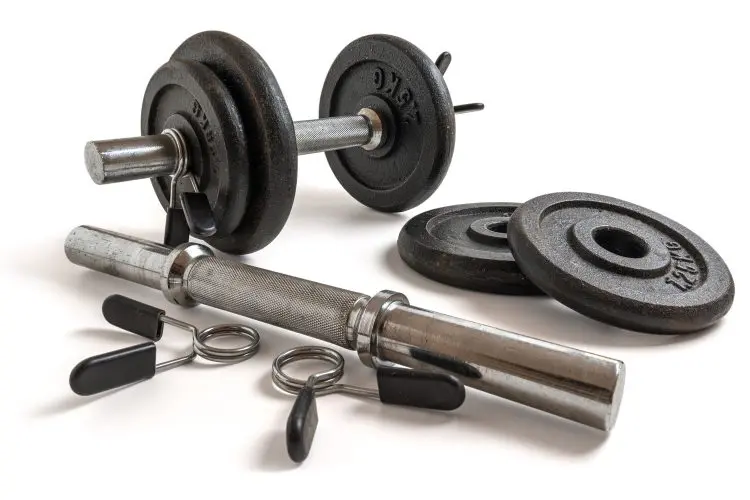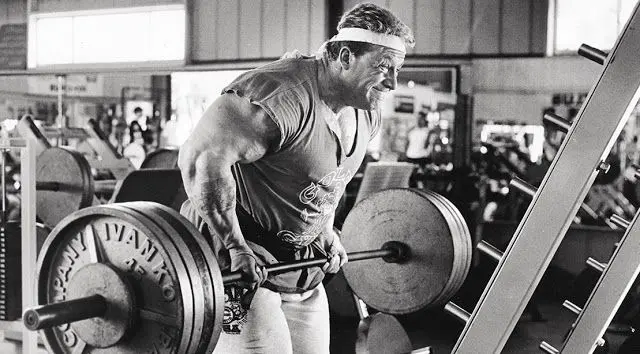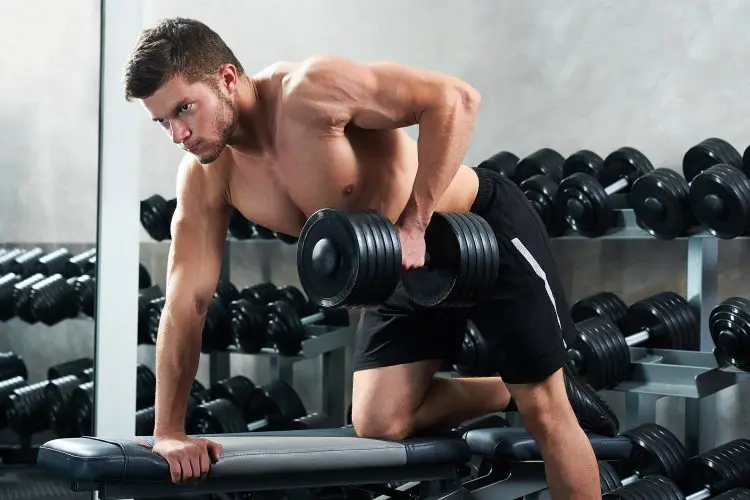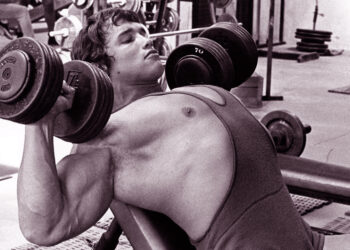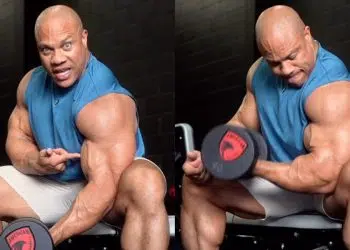Whether you work out at home or at a gym, at some point, you’ll probably need to choose between training with barbells or dumbbells. Maybe it’s chest day, and you need to choose dumbbell or barbell bench presses. Or perhaps it’s arm day, and you have to decide between barbell and dumbbell curls.
In the battle between barbells vs. dumbbells, it’s safe to say both of these training tools are effective. In an ideal world, most lifters should use barbells AND dumbbells as they both have advantages and benefits.
But there may be times when you have to pick one or the other. Maybe you’re equipping a new home gym, or just want the best workout tool for the exercise you are about to do. You might even need a specific tool for your personal training goal.
In this article, we’re going to take a deep dive into the pros and cons of barbells vs. dumbbells so that you can make the right choice for your needs.
Barbells vs. Dumbbells – History
The history of barbells and dumbbells probably won’t affect your decision when choosing between these two different training tools, but it’s kinda interesting and worth mentioning!
Dumbbells are the oldest of the two and have been around since about 700BC. They were used in ancient Greece by athletes. Besides exercising, these early dumbbells, called halteres, were used by long jumpers in an effort to increase performance (1). They’d swing the weights ahead of them on take-off and use them for extra momentum.
Level Up Your Fitness: Join our 💪 strong community in Fitness Volt Newsletter. Get daily inspiration, expert-backed workouts, nutrition tips, the latest in strength sports, and the support you need to reach your goals. Subscribe for free!
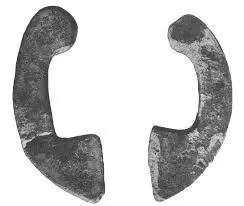
Ancient Romans also used hand weights for strength training, especially for preparing gladiators and soldiers for combat.
The name for dumbbells comes from 18thcentury England. The term was first used to describe a training apparatus that allowed bell ringers to practice without making any sound. In this instance, dumb doesn’t mean stupid. Instead, it means noiseless.
Barbells are a more recent invention and have been in use since the mid 19thcentury. Around this time, exercisers started to move away from light strength training, and there was an increased need and desire to lift heavier weights. Lifting a barbell requires less balance and agility than dumbbells, and they were born out of this change in fitness fashion.
Old-time barbells were fixed weights, and the bar itself did not revolve as modern bars do. This made them very hard to lift, especially from the floor to shoulder or above head height. But, during the early part of the 20thcentury, plate loading barbells became the norm, and the revolving sleeves were invented. Barbell length and weight also became standardized, and the Olympic barbell we all know and love was born.
Different Types of Barbells
When choosing between barbells and dumbbells, and especially if you are going to buy them yourself, it’s worth considering the different types of barbells and dumbbells that are available. First, we’ll start with barbells.
Olympic Bars
Olympic bars are probably the most recognizable and well-known of all the barbells. The best ones are a standard weight and diameter, although they aren’t all the same. A standard Olympic barbell is 2.2 meters (7.2 ft) long and weighs 20 kilograms (44 lb.). The outer ends are 1.96 inches (50 mm) in diameter, while the grip is 28 millimeters (1.1 in) in diameter and 1.31 meters (4.3 ft) in length. The end sleeves revolve, which makes exercises like cleans and snatches much easier.
The best quality Olympic bars are insanely strong and are rated up to 1000lbs or more. However, such bars are also expensive. Cheaper bars aren’t as strong, but unless you are a competitive powerlifter, a bar rated to around 500lbs should be strong enough.
There are also Olympic bars made specifically for women, which are a little shorter and lighter. These bars are also good for beginners or anyone who doesn’t want such a long, heavy bar. Women’s Olympic bars are 6.59 feet long and weigh 33lbs.
Standard Barbell
Standard barbells are usually about five-feet long, one-inch thick, and weigh between 15-20 pounds. Not big or strong enough for weightlifting or powerlifting, these bars are commonly used for home training and less serious strength training workouts.
They do not have revolving sleeves, which means they aren’t so good for the Olympic lifts. On the plus side, they’re a lot cheaper than Olympic bars, and because they’re shorter, they’re also useful if you have limited training space.
Fixed Weight Barbell
Fixed weight barbells are common in gyms. Usually used for freestanding exercises, these bars are generally quite short and are often stored near the dumbbells where they’re used for biceps and triceps training. Body bars are another example of fixed weight barbells.
Trap Bars
Trap bars, also known as hex bars, are designed for doing a type of deadlift during which you stand between the handles. This exercise is also called a squat lift, which is very appropriate because while you are doing a deadlift, the leg action closely resembles squatting.
This type of bar comes in all weights and lengths, from models designed for home use to very heavy-duty bars for commercial gyms. The main disadvantage of trap bars is that they can’t be used for many exercises. For example, unlike a standard or Olympic barbell, you can’t really use a trap bar for bench presses, curls, or skull crushers.
Fit Bar
Fat bars are much thicker than the average barbell. This makes them a lot harder to grip. They can be used for almost any exercise but using one is an excellent way to strengthen your hands and build bigger forearms.
Safety Squat Bar
Safety squat bars have a sort of padded yoke, which means they sit comfortably on your upper back, and you hold them with a shoulder-width, parallel grip just in front of your shoulders. The weights are positioned below your shoulders, lowering your center of gravity and increasing glute and hamstring activation. Popular with powerlifters, these bars can only really be used for squats and good mornings.
Cambered Bars
Cambered bars are designed specifically for squats. They allow the weight to hang down near your hips rather than up at shoulder-height.
This makes them very stable and comfortable to use, and also much easier on your shoulders during squats because you won’t have to contort your arms so much to take a firm grip on the bar. However, like the safety squat bar, cambered bars are only really suitable for squats and good mornings. This type of bar is mainly used by powerlifters.
Bench Press Bars
The Bench press bars are bent so you can lift and lower the weight through a greater range of motion. This makes bench pressing harder, which could lead to an increase in strength and muscle mass.
But, on the downside, this bar may cause extra shoulder wear and tear and injuries. This bar is designed mainly for bench pressing, although it could conceivably be used for bent-over rows and squats too.
Football Bars
Football bars aren’t suitable for squats and deadlifts but are great for upper body training. They have several different handles, so you can use a parallel or semi-parallel grip and move your hands wider or closer together as needed. Most football bars weigh about the same as a regular Olympic bar and can be used inside a squat rack or on a bench press station.
Level Up Your Fitness: Join our 💪 strong community in Fitness Volt Newsletter. Get daily inspiration, expert-backed workouts, nutrition tips, the latest in strength sports, and the support you need to reach your goals. Subscribe for free!
Different Types of Dumbbells
Like the various barbells listed above, there are several different types of dumbbells for you to choose from, and each has advantages, benefits, and drawbacks.
Fixed-weight Dumbbells
Fixed-weight dumbbells are the standard in most gyms. They usually come in pairs and can have round or hexagonal weights. They range from as little as 2.5kg (5lbs) or less up to 50kg (110lbs) or more. Fixed weight dumbbells are convenient to use as you don’t have to do anything to increase or decrease your weights. Just grab the ones you want from the rack and get to work.
On the downside, because they aren’t adjustable, you’ll need to buy at least a few pairs, so you have a selection of weights for your workout. You’ll also need plenty of storage space, which may be a disadvantage for home exercisers. Fixed-weight dumbbells are often rubber-coated to protect your floor but can also be made from bare metal.
Standard Dumbbells
Standard dumbbells are shorter versions of the standard barbell described above. They’re light, compact, cheap, and adjustable. Some use spring collars to hold the weights in place, while others have spinlock collars. On the downside, changing the weights on standard dumbbells can take a minute or two, which means you can’t really use them for training systems like drop sets.
Olympic Dumbbells
Olympic dumbbells are thicker, stronger, and more comfortable to use than standard dumbbells. Plus, you can load them with bumper plates.
Most also have revolving sleeves, which can mean they’re easier on your wrists. However, they share the same disadvantages too, as they’re not easy to load and unload, especially quickly. Olympic dumbbells are also more expensive than standard dumbbells.
Selectorized Dumbbells
Selectorized dumbbells are adjustable like standard dumbbells, but changing the weight is a much faster, more straightforward process. With selectorized dumbbells, you either twist a dial or insert a loading pin and then pick up your weights, leaving behind whatever you don’t need. This type of dumbbell is compact and easy to use, making them ideal for home use. However, that convenience comes at a price, and selectorized dumbbells are often very expensive.
Barbells: Pros and Cons
Consider the following to see if barbells are best for you!
Pros:
Lift more weight – barbells allow you to lift more weight than dumbbells. They involve less balance and coordination, leaving you free to focus on adding weight to the bar. If you want to build maximum strength, barbells are probably your best choice.
Best for squats and deadlifts – while you can do squats and deadlifts with dumbbells, the barbell versions usually feel more natural, and are more practical too. This is especially true if you are a powerlifter.
Best for the Olympic lifts – cleans and snatches are much more comfortable to perform using a barbell. You can clean and snatch dumbbells but doing so requires a lot more balance and coordination, making these already challenging exercises even trickier to perform.
Cons:
More space required – working out with a seven-foot barbell means you’re going to need a large training area. Even a five-foot standard bar could be too long for small home gyms.
You may also need a squat stand and bench press station – getting a barbell into position for squats and bench presses can be tricky, so you may need a squat rack and a bench press setup for your workouts. That’s okay if you’ve got the space and can afford to buy them but could be prohibitive if you only have limited space or are on a budget.
Safety – training on your own with a barbell can be dangerous. If you fail to complete a rep, you could find yourself pinned under a heavy bar, especially during bench presses or squats. A power rack will make solo barbell training safer, but they’re both big and expensive.
Dumbbells: Pros and Cons
Like barbells, dumbbells have pros and cons too…
Pros:
Good for small training spaces – in use and for storage, dumbbells don’t take up much space. If you work out at home and don’t have the space for long barbells, dumbbells are a viable, compact alternative.
Safety – if you fail to complete a rep when training with dumbbells, you will probably be able to lower them down without risking injury. This is especially true during bench presses.
Better for balance and coordination – lifting two weights instead of one will provide your nervous system with more of a challenge. Plus, using dumbbells means you’ll be able to spot and then fix any left to right strength imbalances.
Easier on your joints – many exercisers find dumbbell exercises more comfortable than the same movements done with a barbell. Dumbbells allow you to move your joints independently and also adjust your hand position to almost any angle. This can help avoid and reduce wrist, shoulder, and elbow pain.
No squat rack or bench press bench required – all you really need to compliment your dumbbells is a flat or adjustable bench. This saves space and money.
Increased range of motion – with no bar to get in the way, you should find that, with dumbbells, you can use a bigger range of motion for many pressing and rowing exercises. This can be useful for maintaining or even increasing joint mobility, as well as building muscle.
Cons:
Not so good for strength – if you are serious about getting as strong as possible, your workouts should include squats and deadlifts. These exercises are not easy to do with dumbbells, especially if you want to lift big weights.
More balance required – some dumbbell exercises are technically more challenging than the same move done with a barbell. You’ll have to work extra hard to coordinate, balance, and stabilize two weights instead of one.
Not so good for lower body training – while dumbbells are very useful for upper body exercises, they aren’t so good for leg training. Whatever exercise you do, you’ll need to hold the weights in your hands, which will limit how heavy you can go as your grip could fail before your bigger, stronger leg muscles.
Also read: Dumbbells vs. Kettlebells – Which One Should You Use?
Barbells vs. Dumbbells: Wrapping Up
Here we are at the end of the article. We’ve discussed the history, types, and pros and cons of barbells vs. dumbbells, so we should be able to tell you which is better. But the truth is, the answer really depends on YOU!
If you are a powerlifter or weightlifter, want to get super-strong, have plenty of space to train, and have access to a squat rack and bench press station, barbells are probably your best choice.
But, if you have limited workout and storage space, want to take it easy on your joints, and don’t want to lift mega-heavy weights, dumbbells may be the better option. Ultimately, when comparing barbells vs. dumbbells, your training goals and personal circumstances play a part in determining which option is best.
The good news is that whichever option you choose, both barbells and dumbbells can both give you an effective workout, so choose the one that’s right for you.
References:
1 – Research Gate: The “how” and “why” of the ancient Greek long jump with weights: A five-fold symmetric jump in a row?
2 – Lexico: Dumbbell definition and entomology


